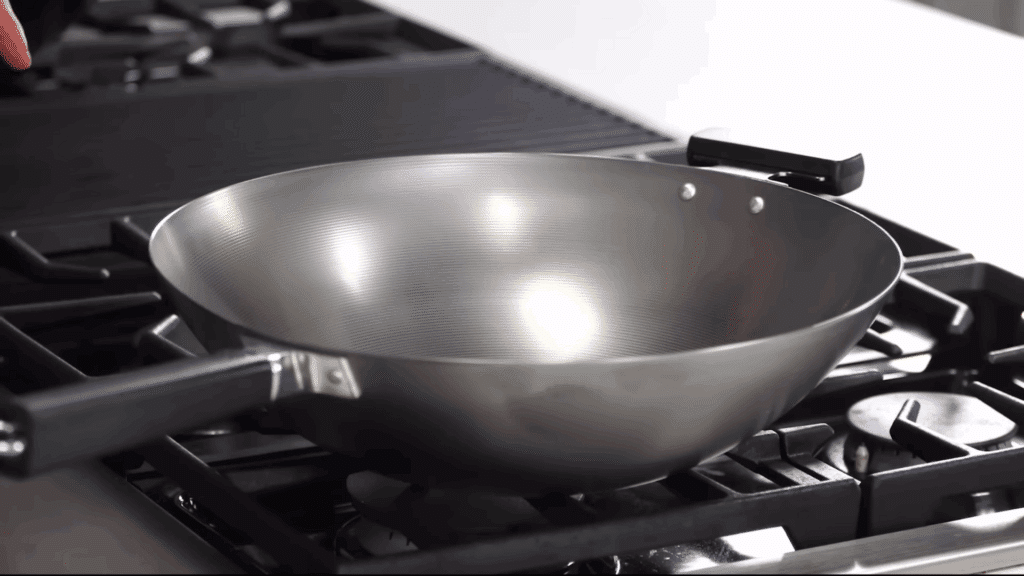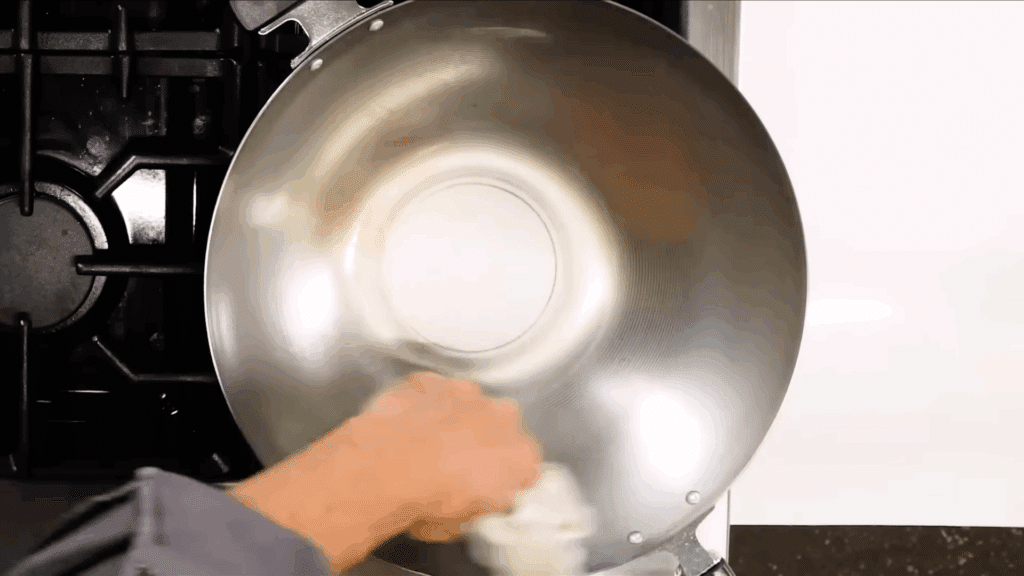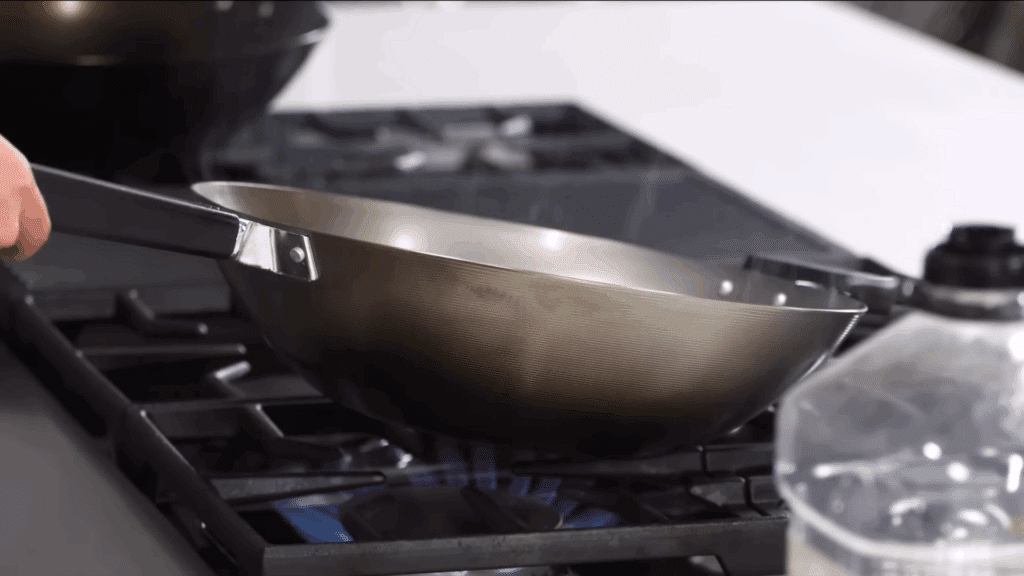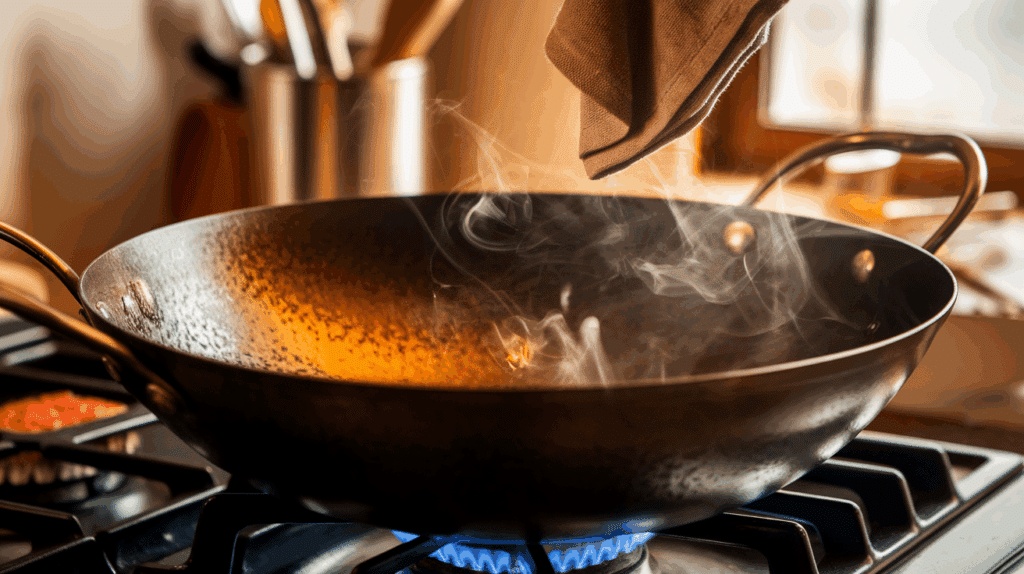When I got my first carbon steel wok, I was excited to use it right away. But I quickly learned that seasoning is the most important first step.
Seasoning builds a natural nonstick layer on the wok and also protects the metal from rust. It may sound complicated, but it’s actually a simple process once you know what to do.
With a little oil, heat, and patience, the wok transforms into a tool that only gets better over time. The more you cook with it, the stronger the seasoning becomes.
I like to think of it as giving the wok a head start before it takes on years of cooking.
In this guide, I’ll walk you through easy steps to season your wok so it’s ready for delicious meals.
Why Carbon Steel Needs Seasoning?
Seasoning works because of a process called polymerization. Heat breaks down oil molecules, which then bond together into a new structure that adheres to the metal surface.
Unlike grease, which stays soft, this new layer hardens into a nonstick, rust-resistant coating.
Carbon steel is especially reactive, which makes it perfect for this transformation. With repeated use and heating, each layer of seasoning builds on the last, creating a smoother, darker, and more nonstick surface over time.
The more you cook with it, especially with fats, the better it gets.
This process not only enhances performance but also adds character to the wok, giving it a deep, rich patina unique to your cooking style.
Over time, your wok becomes naturally nonstick without synthetic coatings, making it safer and more versatile in everyday use.
How to Season a Wok: Step-by-Step Guide
Follow these clear, simple steps to transform your raw carbon steel wok into a naturally nonstick, rust-resistant cooking tool. Each stage builds the foundation for a long-lasting, high-performance surface.
Step 1: Remove the Factory Coating

Woks don’t arrive ready for use; they’re covered in a factory-applied coating to prevent rust during shipping. To start, fill the wok halfway with water, bring it to a boil for five minutes, then dump it out.
Scrub the entire wok (inside and out) using warm, soapy water and a sponge.
This step is critical; if any residue remains, your seasoning will be uneven or peel later.
Dry it immediately after washing. The moment you strip off the coating, raw carbon steel is exposed and highly prone to rust. Don’t wait, move straight to drying and seasoning.
Step 2: Preheat Until Bone Dry

After washing, place the wok over high heat and let it sit until every last drop of moisture evaporates. Look for a fine white smoke, that’s your sign the pan is bone dry and ready for oil.
This step ensures the oil bonds well and prevents rust formation. It’s also a good time to inspect the surface: you may notice slight discoloration as the steel heats, which is normal.
Never skip this drying step. Even invisible moisture can interfere with oil polymerization and cause rust spots to develop under your seasoning.
Step 3: Apply a Micro-Thin Layer of Oil

Take a clean, lint-free cloth or paper towel and dip it lightly into a neutral oil, such as canola, grapeseed, or vegetable oil, which works best. Wipe a micro-thin layer across the entire surface of the wok, inside, outside, and even up the sides.
Buff thoroughly. You shouldn’t see any glistening or pooling. At this point, it should look nearly dry but feel slightly slick.
A thin coat ensures even bonding; too much oil creates sticky or splotchy layers that never fully cure. This is where most beginners go wrong; less is more here.
Step 4: Heat Until the Oil Smokes

Place the oiled wok back on high heat. It will soon begin to smoke. That’s exactly what you want. The smoke signals that the oil has reached its smoking point and is polymerizing, transforming into a durable, solid layer.
This chemical change is the foundation of the seasoning. Once smoking stops and the metal darkens slightly, remove it from the heat. The surface will look more matte and dry.
If there’s still a glossy shine or stickiness, you likely applied too much oil. Wipe it off and try again before proceeding.
Step 5: Repeat the Process 2–3 Times

After the first coat, allow the wok to cool slightly, then repeat the same process: apply another thin coat of oil, wipe thoroughly, and heat until it smokes again.
Each new layer strengthens the surface. By the third coat, your wok should have a noticeably darker tone and feel dry and slick. During this round, also rotate the wok over the flame to hit the edges and exterior.
Three rounds are ideal for building a foundational patina. The more evenly this base forms, the better your wok performs during actual cooking.
This blog has been inspired by “How to Season a Wok” by @Serious Eats on YouTube; for a more detailed understanding, watch-
How to Know the Wok Is Properly Seasoned?
You’ll see a clear visual change as the wok seasons, it goes from raw silver or gunmetal gray to a honey-gold shade, then darkens into deep brown or black with continued use.
A properly seasoned wok will look slightly glossy but feel dry and hard, not sticky, gummy, or oily. When you run your fingers across it, the surface should feel smooth and firm.
A great test is to fry an egg using just a little oil. If it glides around easily without sticking, your seasoning is working.
The color may be uneven at first, but that improves with more cooking.
Don’t rush it; seasoning is a gradual build-up, not a one-time fix. Patience and frequent high-heat cooking will make it better over time.
Caring for Your Carbon Steel Wok
Once your wok is seasoned, proper care and cooking habits help maintain its nonstick surface and extend its life.
| Care / Habit | What to Do | Why It Helps |
|---|---|---|
| Cooking Methods | Stick to stir-frying, pan-frying, and sautéing with oil. | Reinforces the seasoning layer each time you cook. |
| Use More Oil Early On | Add a bit more oil during the first few weeks. | Protects the surface and speeds up seasoning buildup. |
| Gentle Cleaning | Wash with warm water and a soft sponge or brush. Avoid harsh soap and dishwashers. | Preserves the seasoning layer. |
| Dry with Heat | Heat the wok on the stove right after rinsing. | Prevents rust and keeps the surface dry. |
| Avoid Soaking | Never soak in water or leave wet food inside. | Stops rust and damage to the seasoning. |
| Spot Reseasoning | For rust or lost seasoning, scrub lightly, dry, and reseason the area. | Restores protection without redoing the whole wok. |
| Long-Term Use | Keep cooking with it regularly. | The wok becomes more nonstick and durable over the decades. |
Tips for Maintaining Your Wok
A well-seasoned wok can last for decades, but it needs the right care to stay in top shape. Below are some simple tips to keep your wok strong, rust-free, and naturally nonstick:
- Always dry it after washing: After each use, rinse with water, dry thoroughly, and reheat to evaporate all moisture.
- Use a bit of oil after cleaning: Wipe the inside with a tiny drop of oil to protect the surface before storing.
- Avoid cooking acidic foods early: Vinegar, tomatoes, or citrus can strip the young seasoning layers.
- Fry fatty foods early on: Cooking with pork belly or bacon helps build seasoning faster.
- Store in a dry spot: Keep the wok away from humidity. Never leave it soaking in water.
Common Mistakes to Avoid While Seasoning a Wok
Seasoning a carbon steel wok is simple, but small mistakes can make the process harder or damage your hard work. Look at these pitfalls to watch out for:
- Too much oil during seasoning: Thick layers of oil don’t bond; they burn and flake. Thin is always better.
- Skipping the exterior: Only seasoning the inside invites rust outside. Coat the entire wok.
- Touching the wok while hot: Safety first, use tongs or oven mitts while rotating or oiling.
- Not waiting for smoking to stop: Rushing the polymerization leads to tacky residue. Wait it out.
- Using soap aggressively later: After seasoning, stick to hot water and a wok brush. Soap can strip patina.
Conclusion
Seasoning a carbon steel wok isn’t just about following a recipe; it’s about building a surface that grows better with time. Starting from bare metal, you transform it using heat, oil, and patience.
Thin layers of high-smoke-point oil, fully dried and smoked over intense heat, form the base of a lifetime of use.
The result is a durable, nonstick surface that gets better every time you cook.
This process may seem like a chore at first, but it’s worth every step. Once seasoned and maintained, your wok will serve you reliably, cook after cook.
It becomes more than a pan; it becomes part of your kitchen identity. Each meal adds character to its surface. Treat it well, and it will reward you for years to come.
The more you use it, the smoother it gets. That’s not just seasoning, it’s cooking history built layer by layer.


